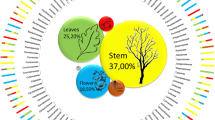Abstract
The efficacies of some indigenous herbal dyes for use in staining plant materials were examined to obtain non-toxic, eco-friendly and cheap stains for use in plant histology. Dye extracts from Bixa orellana, Curcuma domestica, Lonchocarpus cyanescens and Pterocarpus osun were used to stain wood sections using the existing standard staining procedures with little modification. All the extracts had affinity for the fibre and vessel elements except the extract from L. cyanescens. The extracts from C. domestica and B. orellana had higher selectivity than those of P. osun for fibre. From the results of the absorbance curves, each of the dye extracts from all speciese had minimum of two peaks, indicating that they had two or more colour imparting chromophores except dye extract from C. domestica. All the dye extracts were acidic with pH range of 3.77 to 6.77. Therefore, this study shows that dye extracts from B. orellana, C. domestica and P. osun could be solitarily or in combination with artificial dyes for plant histological staining.
Similar content being viewed by others
References
Avwioro OG, Aloamaka PC, Ojianya NU, Oduola T, Ekpo EO. 2005. Extracts of Pterocarpus osun as a histological stain for collagen fibres. Afr. J. Biotechnol., 4(5): 460–462.
Avwioro OG, Awoyemi FA, Oduola T. 2005. A novel natural collagen and muscle stain from Morinda lucida extracts. The Int. Med. J., 4(2): 44–48.
Avwioro OG. 2002. Histochemistry and tissue pathology. 1st ed. Ibadan, Nigeria: Claverianun Press, pp. 134–213.
Baker FJ, Silverton RE. 1976. The theory of staining. In: Introduction to Medical Laboratory Technology, 6th ed. London: Butterworths and Co, London, pp. 385–391.
Banderanayake WM. 1999. Traditional and medical uses of Mangoves. Mangroves and Salt Marslec, 2(3): 133–148.
Bhuyan R, Saikia CN. 2004. Isolation of colour components from native dyebearing plants in Northeastern India. Am. J. Pathol., 164(5): 873–877.
Eom S, Shin D, Yoon K. 2001. Improving the dyeability of natural colourants on cotton by cationization. Ind. J Fibre Text Re., 26(4): 425–431.
Garg AS. Shenda and K.C. Gupta. 1991. Effect of mordants on colour of natural dye extracted from tissue flowers (Butea mongsperma). Colourage, 38(2): 50–53.
Gaur HS, Chandel ST. 1998. Use of indigenous non-toxic herbal dyes in staining nematodes. Ann. Pl. Protec. Sci., 6(2): 189–219
Lillie RD, Conn’s HJ. 1969. Biological Stains: A handbook on the nature and uses of the dyes employed in the biological laboratory, 8th Ed. Baltimore: The William and Wilkins Company, pp. 86–112
Padhy RN, Rathi D. 1990. Effect of mordants on dyeing of cotton with vegetable dyes. Text Dyer Printer, 23(25): 27–28.
Popoola AV, Ipinmoroti KO, Ogunmoroti TO. 1994. Extraction, spectroscopic and colouring potential studies of the dye in Ginger Rhizome (Zingiber officinale). Pak J Sci Ind Res, 37(5): 217–220.
Author information
Authors and Affiliations
Corresponding author
Rights and permissions
About this article
Cite this article
Akinloye, A.J., Illoh, H.C. & Olagoke, A.O. Screening of some indigenous herbal dyes for use in plant histological staining. Journal of Forestry Research 21, 81–84 (2010). https://doi.org/10.1007/s11676-010-0014-2
Received:
Accepted:
Published:
Issue Date:
DOI: https://doi.org/10.1007/s11676-010-0014-2




